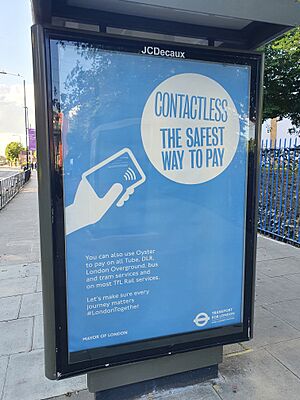Contactless payment facts for kids
Contactless payment lets you pay for things quickly and easily. You can use special cards, key fobs, or even your smartphone. These devices use special radio waves to talk to a payment machine. This technology is called radio-frequency identification (RFID) or near-field communication (NFC).
To pay, you just hold your device close to the payment reader. It's different from other mobile payments that use Wi-Fi. Contactless payments need you to be very close to the machine.
A common standard for these payments is called EMV. This standard was developed by Europay, Mastercard, and Visa. Many credit card companies and phone makers use EMV. You might also see contactless cards used for public transport. For example, the Oyster card in London or the RioCard in Rio de Janeiro. These cards can hold money or even monthly passes.
Popular ways to pay contactlessly include Apple Pay on iPhones and Google Pay on Android phones. These systems use something called tokenization. This means your card details are turned into a special code. This code is then stored safely on your phone.
Contactless payments are often much faster than paying with cash or a regular card. For small purchases, you usually don't need to sign or enter a PIN. This speed makes them very popular. However, because there's no PIN for small amounts, it's important to keep your card safe. If it's lost, someone could make small purchases without you knowing.
Many banks and companies now offer contactless payment options. These cards are very common in countries like the UK, US, and Australia. People tend to spend more when payments are easy. This has made contactless payments very popular. In some places, card payments are now more common than cash. Contactless payments make up a big part of these card transactions. Companies plan to make even more contactless cards available.
Contents
How Contactless Payments Started
Early Steps: 1990s to 2000s
Contactless payment ideas began a long time ago. In 1997, a company called Mobil offered a system called "Speedpass." This let people pay for gas without swiping a card. It was an early example of this technology.
Later, in 2002, Philips and Sony worked together. They helped create the NFC standard. This is the technology many contactless payments use today. Engineers Franz Amtmann and Philippe Maugars were key to this.
In Japan, Sony introduced a "wallet-phone" system in 2004. It allowed people to pay with their mobile phones. This was used for things like train tickets.
By 2005, countries like Germany and France started testing contactless payments. People used special phones to pay in shops or on public transport. These early tests helped show how useful contactless payments could be.
The first contactless cards in the UK came out in 2007. Soon after, the first phones with NFC payment features were tested in New York. In 2008, a restaurant chain called Eat was one of the first to use contactless payments widely.
Growing Popularity: 2010s
In 2010, more companies started working together. For example, Barclaycard and Orange launched a contactless credit card in the UK. Public transport systems also began to adopt contactless payments. Nice, France, was one of the first European cities to use NFC for buses and trams in 2010.
By 2011, mobile phones started getting official certifications for contactless payments. This meant you could link your card to your phone. In 2014, Apple Inc. launched Apple Pay. This made paying with iPhones very popular. Also in 2014, London's Tube system began accepting contactless payments. This made travel much easier for many people.
Around 2016, contactless payments became even more common. You could even use wearable technology like smartwatches to pay. This showed how much the technology was growing.
Recent Developments: 2020s

During the COVID-19 pandemic, contactless payments became even more important. Many banks increased the amount you could pay without a PIN. This was to help people avoid touching keypads or handling cash. For example, in the UK, the limit went up to £100.
In 2022, Apple introduced "Tap to Pay." This feature lets businesses use an iPhone as a payment terminal. It means they can accept contactless payments directly on their phone.
Who Uses Contactless Payments?
Many people use contactless payments every day. Apps like Google Pay let Android phone users pay with NFC. This technology has improved over time, making it easier for phones to act like payment cards.
Companies have noticed that people tend to spend more when payments are quick and easy. This is one reason why contactless payments have grown so much. In the UK, for example, card payments are now more common than cash. Contactless payments make up a large part of these card transactions.
In countries like Australia, contactless payments are very popular. Most purchases there are now made using this method. Banks and card companies are continuing to make more contactless cards available to people.
Many big banks and payment companies around the world now offer contactless systems. These include Mastercard, Visa, and American Express. They offer special contactless cards that are widely used in many countries.
How Contactless Technology Works
Contactless payments use special technology to keep your money safe. There are a few main parts to how it all works.
EMV Chips
Many bank cards have a tiny computer chip called an EMV chip. This is a "smart chip." When you tap your card, this chip talks wirelessly to the payment machine. It uses radio-frequency identification (RFID) to do this. The machine checks your card's details. Sometimes, you might need to enter your PIN to confirm the payment.
Tokenization for Safety
When you use your phone for contactless payments, like with Apple Pay, it often uses something called tokenization. This is a clever way to keep your real card number secret. Instead of sending your actual card number, your phone creates a special, temporary code called a "token."
This token is sent to the payment machine. The bank then uses this token to approve your payment. This makes your transactions more secure. Even if someone got the token, it wouldn't be your actual card number.
Near Field Communication (NFC)
The main technology behind contactless payments is NFC. This uses radio waves to send information over very short distances. Think of it like a tiny, super-short-range radio.
NFC only works when your device is very close to the reader. Usually, it needs to be within 4 centimeters (about 1.5 inches). This short distance helps keep your payments secure. It means someone can't easily read your card from far away.
Keeping Your Payments Safe
Security is very important for contactless payments. Early on, some researchers found ways to read card details. But technology has improved a lot since then.
Contactless payments use the same secure systems as regular chip and PIN cards. This means your payments are protected. Banks often have rules to protect you if unauthorized purchases happen.
Payment Limits
To add more safety, there's often a limit on how much you can spend in one go without entering your PIN. This is called a Cardholder Verification Limit (CVM limit). If your purchase is over this limit, you'll usually need to enter your PIN or use another way to prove it's you, like a fingerprint.
These limits are different in various countries and for different banks. For example, in the UK, the limit for a single tap without a PIN is £100. But if you use your phone with Apple Pay or Google Pay, these limits often don't apply. This is because your phone uses extra security, like your fingerprint or face scan, to confirm it's you.
See also
- Apple Pay
- Digital currency
- Contactless smart card
- Cashless society
- Dashtop mobile
- Google Pay
- Microsoft Pay
- Mobile payment
- Near field communication
- Proximity card
- Octopus card
- Opus card
- Oyster card
- Opal card
- Presto card
- Rav-Kav
- Ventra
- Samsung Pay
- Softcard (formerly Isis mobile wallet)
- Vicinity cards



